Comparison of Australian and US Healthcare Systems
VerifiedAdded on 2023/03/23
|17
|4533
|92
AI Summary
This article compares the healthcare systems of Australia and the United States, focusing on healthcare costs, funding sources, government legislation, health coverage, and financing. It examines the differences between the two systems and their impact on healthcare delivery and accessibility.
Contribute Materials
Your contribution can guide someone’s learning journey. Share your
documents today.
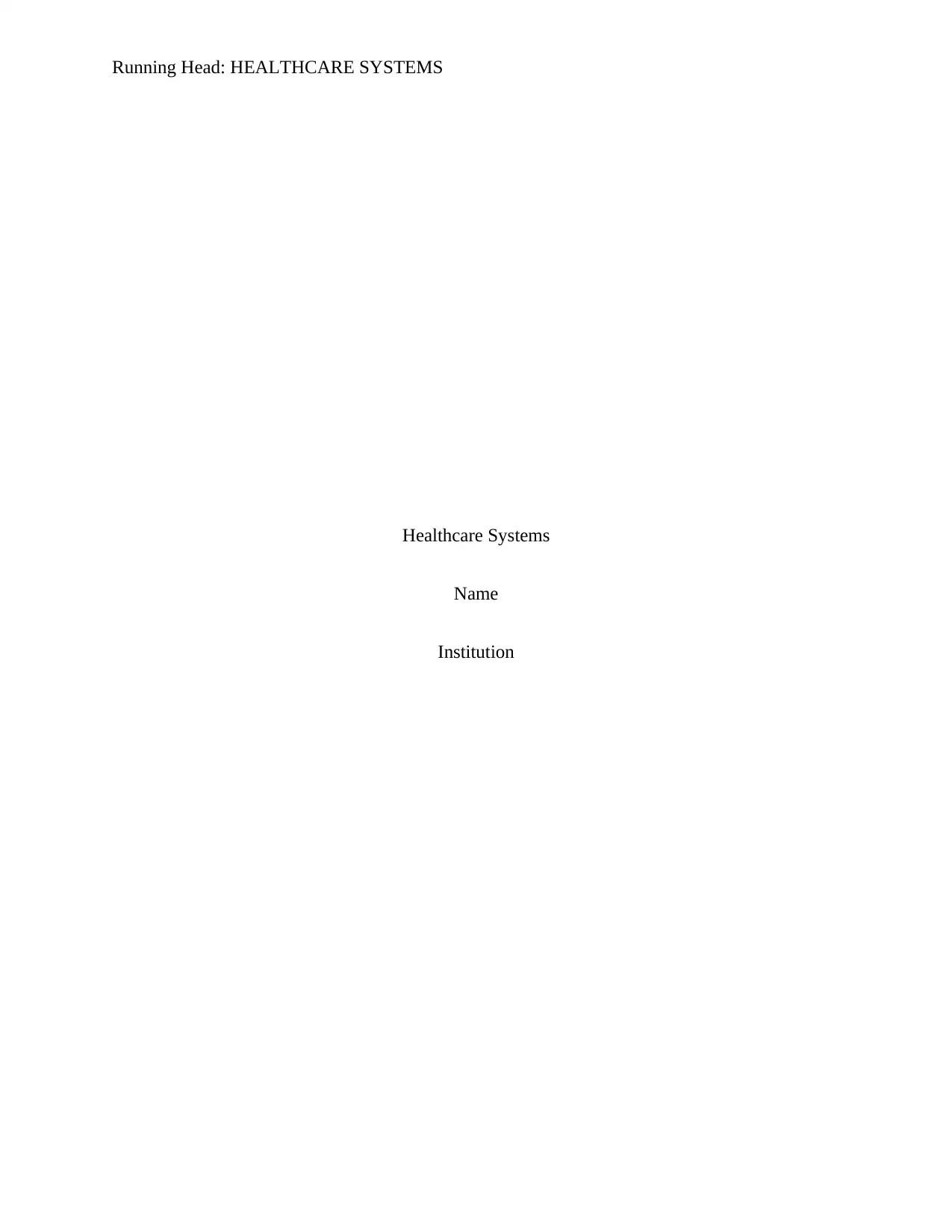
Running Head: HEALTHCARE SYSTEMS
Healthcare Systems
Name
Institution
Healthcare Systems
Name
Institution
Secure Best Marks with AI Grader
Need help grading? Try our AI Grader for instant feedback on your assignments.
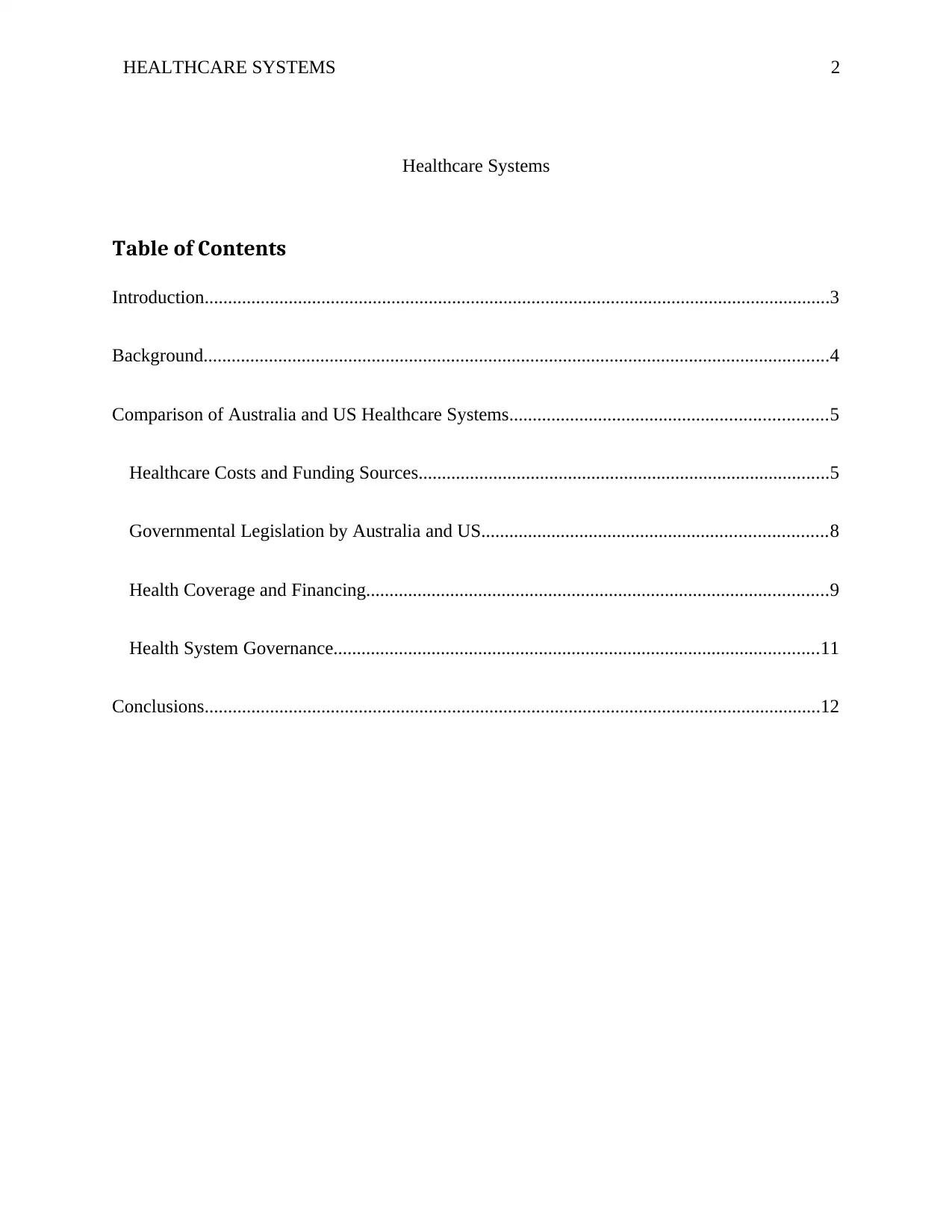
HEALTHCARE SYSTEMS 2
Healthcare Systems
Table of Contents
Introduction......................................................................................................................................3
Background......................................................................................................................................4
Comparison of Australia and US Healthcare Systems....................................................................5
Healthcare Costs and Funding Sources........................................................................................5
Governmental Legislation by Australia and US..........................................................................8
Health Coverage and Financing...................................................................................................9
Health System Governance........................................................................................................11
Conclusions....................................................................................................................................12
Healthcare Systems
Table of Contents
Introduction......................................................................................................................................3
Background......................................................................................................................................4
Comparison of Australia and US Healthcare Systems....................................................................5
Healthcare Costs and Funding Sources........................................................................................5
Governmental Legislation by Australia and US..........................................................................8
Health Coverage and Financing...................................................................................................9
Health System Governance........................................................................................................11
Conclusions....................................................................................................................................12
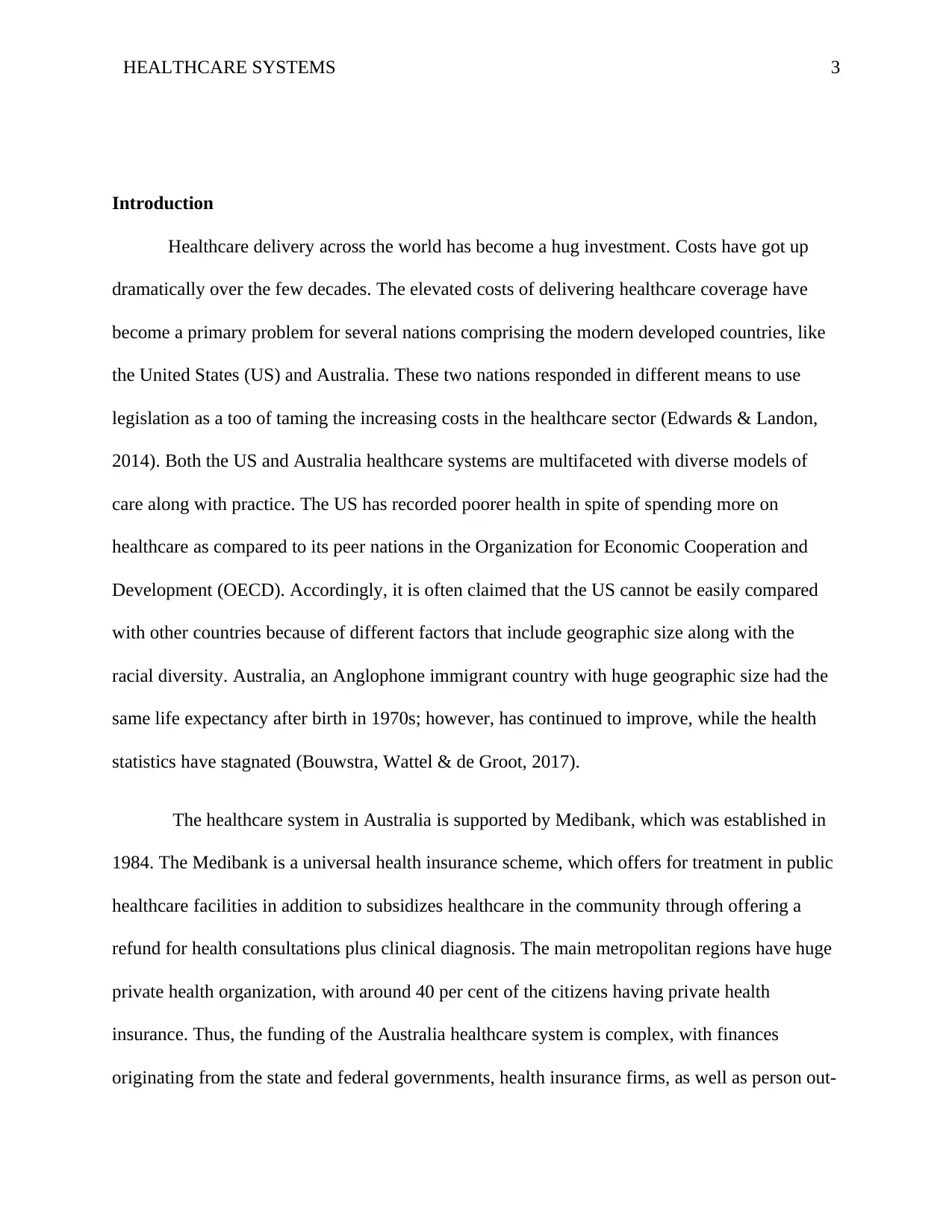
HEALTHCARE SYSTEMS 3
Introduction
Healthcare delivery across the world has become a hug investment. Costs have got up
dramatically over the few decades. The elevated costs of delivering healthcare coverage have
become a primary problem for several nations comprising the modern developed countries, like
the United States (US) and Australia. These two nations responded in different means to use
legislation as a too of taming the increasing costs in the healthcare sector (Edwards & Landon,
2014). Both the US and Australia healthcare systems are multifaceted with diverse models of
care along with practice. The US has recorded poorer health in spite of spending more on
healthcare as compared to its peer nations in the Organization for Economic Cooperation and
Development (OECD). Accordingly, it is often claimed that the US cannot be easily compared
with other countries because of different factors that include geographic size along with the
racial diversity. Australia, an Anglophone immigrant country with huge geographic size had the
same life expectancy after birth in 1970s; however, has continued to improve, while the health
statistics have stagnated (Bouwstra, Wattel & de Groot, 2017).
The healthcare system in Australia is supported by Medibank, which was established in
1984. The Medibank is a universal health insurance scheme, which offers for treatment in public
healthcare facilities in addition to subsidizes healthcare in the community through offering a
refund for health consultations plus clinical diagnosis. The main metropolitan regions have huge
private health organization, with around 40 per cent of the citizens having private health
insurance. Thus, the funding of the Australia healthcare system is complex, with finances
originating from the state and federal governments, health insurance firms, as well as person out-
Introduction
Healthcare delivery across the world has become a hug investment. Costs have got up
dramatically over the few decades. The elevated costs of delivering healthcare coverage have
become a primary problem for several nations comprising the modern developed countries, like
the United States (US) and Australia. These two nations responded in different means to use
legislation as a too of taming the increasing costs in the healthcare sector (Edwards & Landon,
2014). Both the US and Australia healthcare systems are multifaceted with diverse models of
care along with practice. The US has recorded poorer health in spite of spending more on
healthcare as compared to its peer nations in the Organization for Economic Cooperation and
Development (OECD). Accordingly, it is often claimed that the US cannot be easily compared
with other countries because of different factors that include geographic size along with the
racial diversity. Australia, an Anglophone immigrant country with huge geographic size had the
same life expectancy after birth in 1970s; however, has continued to improve, while the health
statistics have stagnated (Bouwstra, Wattel & de Groot, 2017).
The healthcare system in Australia is supported by Medibank, which was established in
1984. The Medibank is a universal health insurance scheme, which offers for treatment in public
healthcare facilities in addition to subsidizes healthcare in the community through offering a
refund for health consultations plus clinical diagnosis. The main metropolitan regions have huge
private health organization, with around 40 per cent of the citizens having private health
insurance. Thus, the funding of the Australia healthcare system is complex, with finances
originating from the state and federal governments, health insurance firms, as well as person out-

HEALTHCARE SYSTEMS 4
of-pocket contributions. Similarly, the US has a broad array of healthcare schemes, which differ
amongst different states, with the majority healthcare financed by some kind of health insurance
scheme, totally privately or government-funded. The American government established
Medicaid and Medicare plans in 1965 to offer healthcare to its people aged 65 years and above
plus to lower-income patients, correspondingly (Raparelli, Pilote, Krumholz & Dreyer, 2018).
The paper will compare the Australian healthcare system and the US healthcare system
by drawing different elements of the systems to understand the differences in both healthcare
systems.
Background
At the moment, Australia has a universal national healthcare care scheme called
Medicare that was re-organized in 1984. The country has a two-tier healthcare system: private
and public. In Australia, around 57 per cent citizens select to have private health plan that may
complement allied healthcare services, plus dental and allow access to private healthcare
facilities. The Australian regime does advocate that those people who receive over definite brink
get private health insurance plan to mitigate disastrous loss. Differently, the US that has a
scheme of marketplace fairness, Australia has a healthcare system of social justice, which
considers all citizens must have basic healthcare (Esmail & MacKinnon, 2013). Presently, there
is a primary apprehension for the Indigenous people of Australia plus these people attaining
basic healthcare because of their rural setting plus self-dependence on the land to sustain them
spiritually plus physically. It is important to understand that same ideas, which assisted to craft
the culture of early Americans. Additionally, Australia has a highly centralized centre for
of-pocket contributions. Similarly, the US has a broad array of healthcare schemes, which differ
amongst different states, with the majority healthcare financed by some kind of health insurance
scheme, totally privately or government-funded. The American government established
Medicaid and Medicare plans in 1965 to offer healthcare to its people aged 65 years and above
plus to lower-income patients, correspondingly (Raparelli, Pilote, Krumholz & Dreyer, 2018).
The paper will compare the Australian healthcare system and the US healthcare system
by drawing different elements of the systems to understand the differences in both healthcare
systems.
Background
At the moment, Australia has a universal national healthcare care scheme called
Medicare that was re-organized in 1984. The country has a two-tier healthcare system: private
and public. In Australia, around 57 per cent citizens select to have private health plan that may
complement allied healthcare services, plus dental and allow access to private healthcare
facilities. The Australian regime does advocate that those people who receive over definite brink
get private health insurance plan to mitigate disastrous loss. Differently, the US that has a
scheme of marketplace fairness, Australia has a healthcare system of social justice, which
considers all citizens must have basic healthcare (Esmail & MacKinnon, 2013). Presently, there
is a primary apprehension for the Indigenous people of Australia plus these people attaining
basic healthcare because of their rural setting plus self-dependence on the land to sustain them
spiritually plus physically. It is important to understand that same ideas, which assisted to craft
the culture of early Americans. Additionally, Australia has a highly centralized centre for
Paraphrase This Document
Need a fresh take? Get an instant paraphrase of this document with our AI Paraphraser

HEALTHCARE SYSTEMS 5
allocation of health services, which are under the Minister of health and Aging. The country
spent around 9.1& of its GDP on healthcare in 2007.
On the other side, the US healthcare system is frequently explained as disjointed since
there is no central office or department to manage the supply, assignment, as well as the quantity
of healthcare resources to generate the most processes, access or generate the most excellent
results (Shi & Singh, 2010). In the US, there is no central system of planning and this has
resulted to unequal physicians in metropolitan areas that leave countryside regions in need of
capable persons to offer health services. Financially, healthcare in the US is the biggest
employer employing over 14.4 million individuals (White & Griffith, 2010). The US people have
no entitlement to healthcare coverage. The safety nets exist to safeguard susceptible persons,
such as Medicaid for the poor, disabled and low-income persons and households; however, they
should be eligible on the federal deficiency stage. Medicaid in the US is financed partly by the
State where individual o family live while from recompense by the federal regime at around
50/50 normal. In the end, all people of the US be entitled for Medicare at the 65 years or before
for a few unique situations. Medical experiences have persisted to increase on annual basis, for
many decades. In 2010 only, the healthcare costs in US reached $2.7 trillion, which was nearly
17% of the GNP, but these costs are anticipated to increase as a towering as 20 per cent of the
GDP by 2020 (Healey & Smith, 2011).
Comparison of Australia and US Healthcare Systems
Healthcare Costs and Funding Sources
allocation of health services, which are under the Minister of health and Aging. The country
spent around 9.1& of its GDP on healthcare in 2007.
On the other side, the US healthcare system is frequently explained as disjointed since
there is no central office or department to manage the supply, assignment, as well as the quantity
of healthcare resources to generate the most processes, access or generate the most excellent
results (Shi & Singh, 2010). In the US, there is no central system of planning and this has
resulted to unequal physicians in metropolitan areas that leave countryside regions in need of
capable persons to offer health services. Financially, healthcare in the US is the biggest
employer employing over 14.4 million individuals (White & Griffith, 2010). The US people have
no entitlement to healthcare coverage. The safety nets exist to safeguard susceptible persons,
such as Medicaid for the poor, disabled and low-income persons and households; however, they
should be eligible on the federal deficiency stage. Medicaid in the US is financed partly by the
State where individual o family live while from recompense by the federal regime at around
50/50 normal. In the end, all people of the US be entitled for Medicare at the 65 years or before
for a few unique situations. Medical experiences have persisted to increase on annual basis, for
many decades. In 2010 only, the healthcare costs in US reached $2.7 trillion, which was nearly
17% of the GNP, but these costs are anticipated to increase as a towering as 20 per cent of the
GDP by 2020 (Healey & Smith, 2011).
Comparison of Australia and US Healthcare Systems
Healthcare Costs and Funding Sources
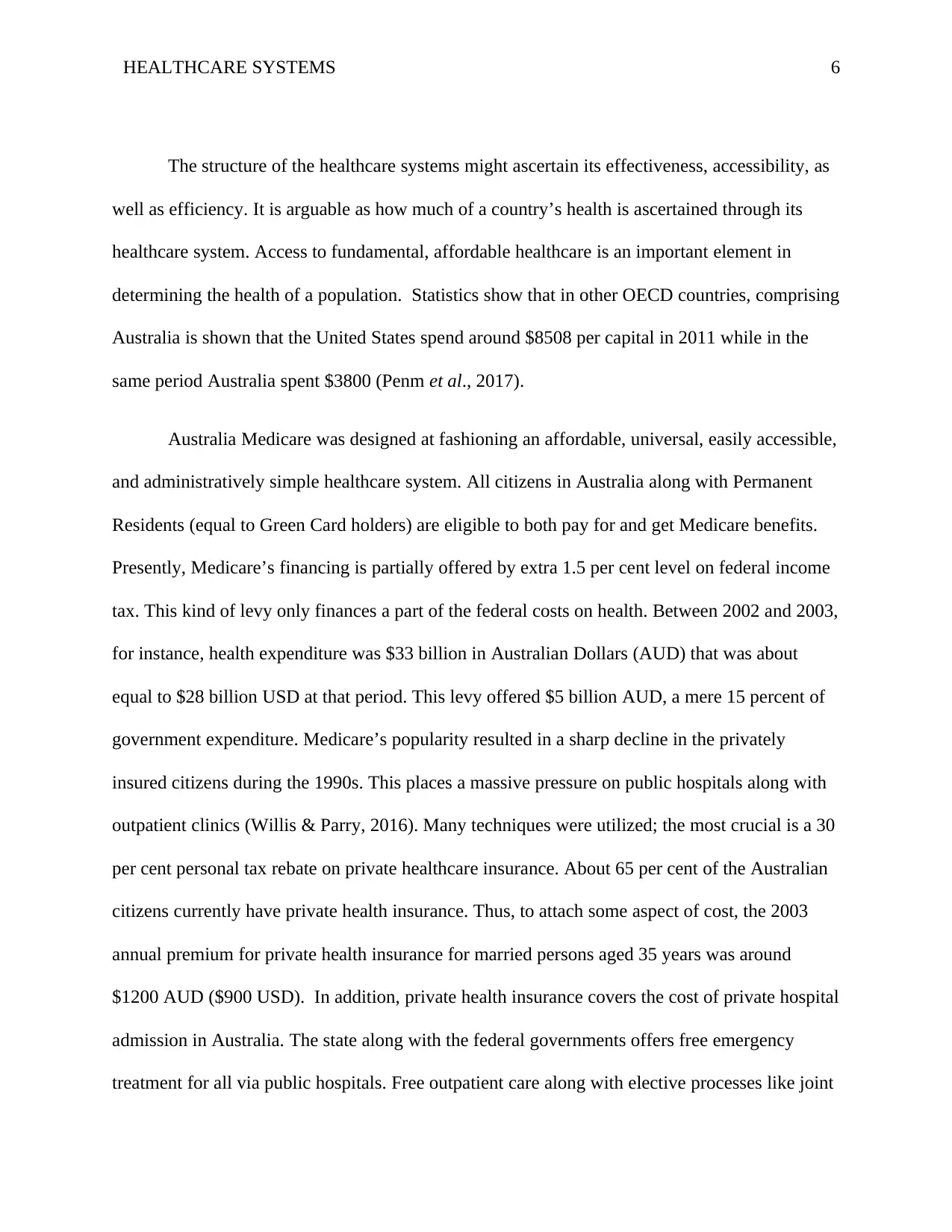
HEALTHCARE SYSTEMS 6
The structure of the healthcare systems might ascertain its effectiveness, accessibility, as
well as efficiency. It is arguable as how much of a country’s health is ascertained through its
healthcare system. Access to fundamental, affordable healthcare is an important element in
determining the health of a population. Statistics show that in other OECD countries, comprising
Australia is shown that the United States spend around $8508 per capital in 2011 while in the
same period Australia spent $3800 (Penm et al., 2017).
Australia Medicare was designed at fashioning an affordable, universal, easily accessible,
and administratively simple healthcare system. All citizens in Australia along with Permanent
Residents (equal to Green Card holders) are eligible to both pay for and get Medicare benefits.
Presently, Medicare’s financing is partially offered by extra 1.5 per cent level on federal income
tax. This kind of levy only finances a part of the federal costs on health. Between 2002 and 2003,
for instance, health expenditure was $33 billion in Australian Dollars (AUD) that was about
equal to $28 billion USD at that period. This levy offered $5 billion AUD, a mere 15 percent of
government expenditure. Medicare’s popularity resulted in a sharp decline in the privately
insured citizens during the 1990s. This places a massive pressure on public hospitals along with
outpatient clinics (Willis & Parry, 2016). Many techniques were utilized; the most crucial is a 30
per cent personal tax rebate on private healthcare insurance. About 65 per cent of the Australian
citizens currently have private health insurance. Thus, to attach some aspect of cost, the 2003
annual premium for private health insurance for married persons aged 35 years was around
$1200 AUD ($900 USD). In addition, private health insurance covers the cost of private hospital
admission in Australia. The state along with the federal governments offers free emergency
treatment for all via public hospitals. Free outpatient care along with elective processes like joint
The structure of the healthcare systems might ascertain its effectiveness, accessibility, as
well as efficiency. It is arguable as how much of a country’s health is ascertained through its
healthcare system. Access to fundamental, affordable healthcare is an important element in
determining the health of a population. Statistics show that in other OECD countries, comprising
Australia is shown that the United States spend around $8508 per capital in 2011 while in the
same period Australia spent $3800 (Penm et al., 2017).
Australia Medicare was designed at fashioning an affordable, universal, easily accessible,
and administratively simple healthcare system. All citizens in Australia along with Permanent
Residents (equal to Green Card holders) are eligible to both pay for and get Medicare benefits.
Presently, Medicare’s financing is partially offered by extra 1.5 per cent level on federal income
tax. This kind of levy only finances a part of the federal costs on health. Between 2002 and 2003,
for instance, health expenditure was $33 billion in Australian Dollars (AUD) that was about
equal to $28 billion USD at that period. This levy offered $5 billion AUD, a mere 15 percent of
government expenditure. Medicare’s popularity resulted in a sharp decline in the privately
insured citizens during the 1990s. This places a massive pressure on public hospitals along with
outpatient clinics (Willis & Parry, 2016). Many techniques were utilized; the most crucial is a 30
per cent personal tax rebate on private healthcare insurance. About 65 per cent of the Australian
citizens currently have private health insurance. Thus, to attach some aspect of cost, the 2003
annual premium for private health insurance for married persons aged 35 years was around
$1200 AUD ($900 USD). In addition, private health insurance covers the cost of private hospital
admission in Australia. The state along with the federal governments offers free emergency
treatment for all via public hospitals. Free outpatient care along with elective processes like joint
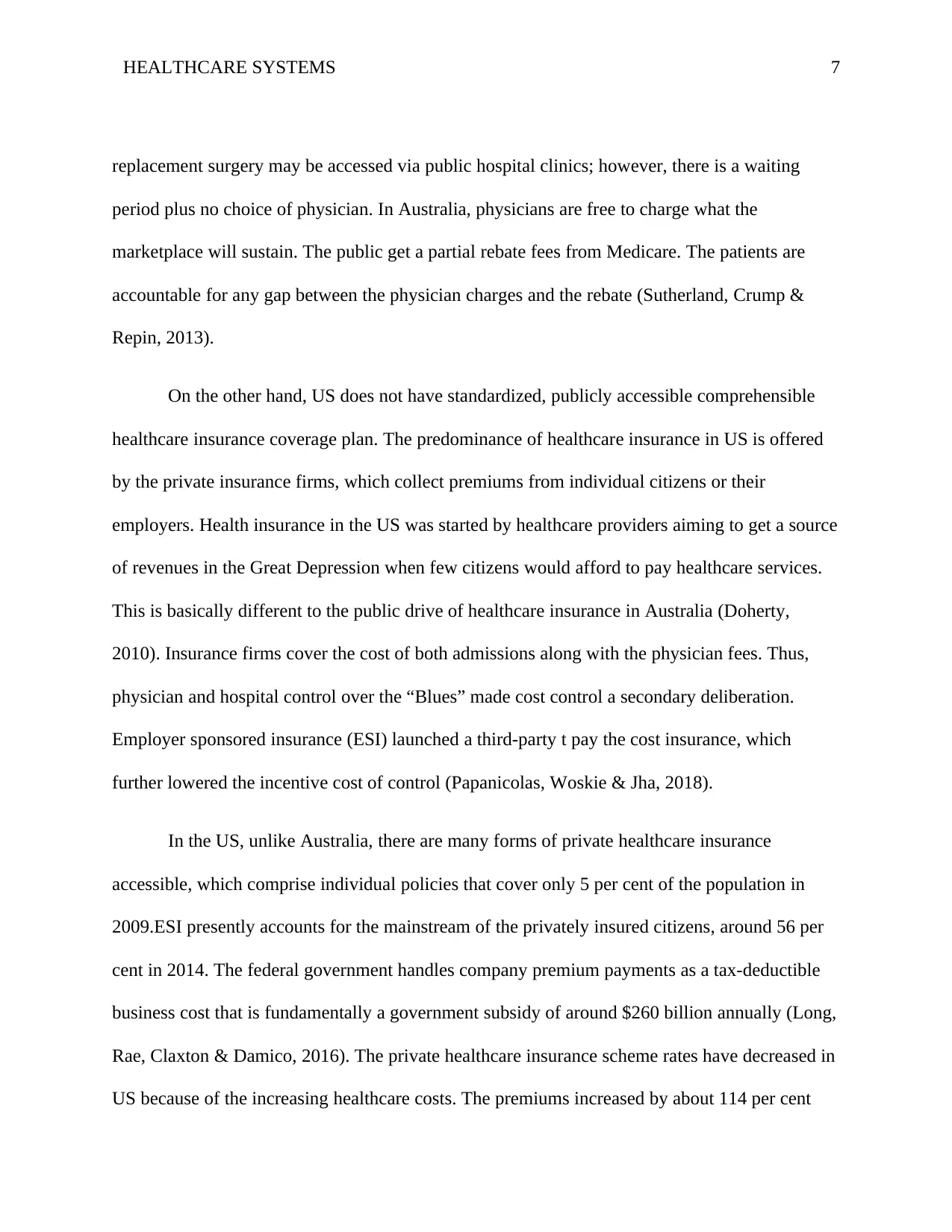
HEALTHCARE SYSTEMS 7
replacement surgery may be accessed via public hospital clinics; however, there is a waiting
period plus no choice of physician. In Australia, physicians are free to charge what the
marketplace will sustain. The public get a partial rebate fees from Medicare. The patients are
accountable for any gap between the physician charges and the rebate (Sutherland, Crump &
Repin, 2013).
On the other hand, US does not have standardized, publicly accessible comprehensible
healthcare insurance coverage plan. The predominance of healthcare insurance in US is offered
by the private insurance firms, which collect premiums from individual citizens or their
employers. Health insurance in the US was started by healthcare providers aiming to get a source
of revenues in the Great Depression when few citizens would afford to pay healthcare services.
This is basically different to the public drive of healthcare insurance in Australia (Doherty,
2010). Insurance firms cover the cost of both admissions along with the physician fees. Thus,
physician and hospital control over the “Blues” made cost control a secondary deliberation.
Employer sponsored insurance (ESI) launched a third-party t pay the cost insurance, which
further lowered the incentive cost of control (Papanicolas, Woskie & Jha, 2018).
In the US, unlike Australia, there are many forms of private healthcare insurance
accessible, which comprise individual policies that cover only 5 per cent of the population in
2009.ESI presently accounts for the mainstream of the privately insured citizens, around 56 per
cent in 2014. The federal government handles company premium payments as a tax-deductible
business cost that is fundamentally a government subsidy of around $260 billion annually (Long,
Rae, Claxton & Damico, 2016). The private healthcare insurance scheme rates have decreased in
US because of the increasing healthcare costs. The premiums increased by about 114 per cent
replacement surgery may be accessed via public hospital clinics; however, there is a waiting
period plus no choice of physician. In Australia, physicians are free to charge what the
marketplace will sustain. The public get a partial rebate fees from Medicare. The patients are
accountable for any gap between the physician charges and the rebate (Sutherland, Crump &
Repin, 2013).
On the other hand, US does not have standardized, publicly accessible comprehensible
healthcare insurance coverage plan. The predominance of healthcare insurance in US is offered
by the private insurance firms, which collect premiums from individual citizens or their
employers. Health insurance in the US was started by healthcare providers aiming to get a source
of revenues in the Great Depression when few citizens would afford to pay healthcare services.
This is basically different to the public drive of healthcare insurance in Australia (Doherty,
2010). Insurance firms cover the cost of both admissions along with the physician fees. Thus,
physician and hospital control over the “Blues” made cost control a secondary deliberation.
Employer sponsored insurance (ESI) launched a third-party t pay the cost insurance, which
further lowered the incentive cost of control (Papanicolas, Woskie & Jha, 2018).
In the US, unlike Australia, there are many forms of private healthcare insurance
accessible, which comprise individual policies that cover only 5 per cent of the population in
2009.ESI presently accounts for the mainstream of the privately insured citizens, around 56 per
cent in 2014. The federal government handles company premium payments as a tax-deductible
business cost that is fundamentally a government subsidy of around $260 billion annually (Long,
Rae, Claxton & Damico, 2016). The private healthcare insurance scheme rates have decreased in
US because of the increasing healthcare costs. The premiums increased by about 114 per cent
Secure Best Marks with AI Grader
Need help grading? Try our AI Grader for instant feedback on your assignments.
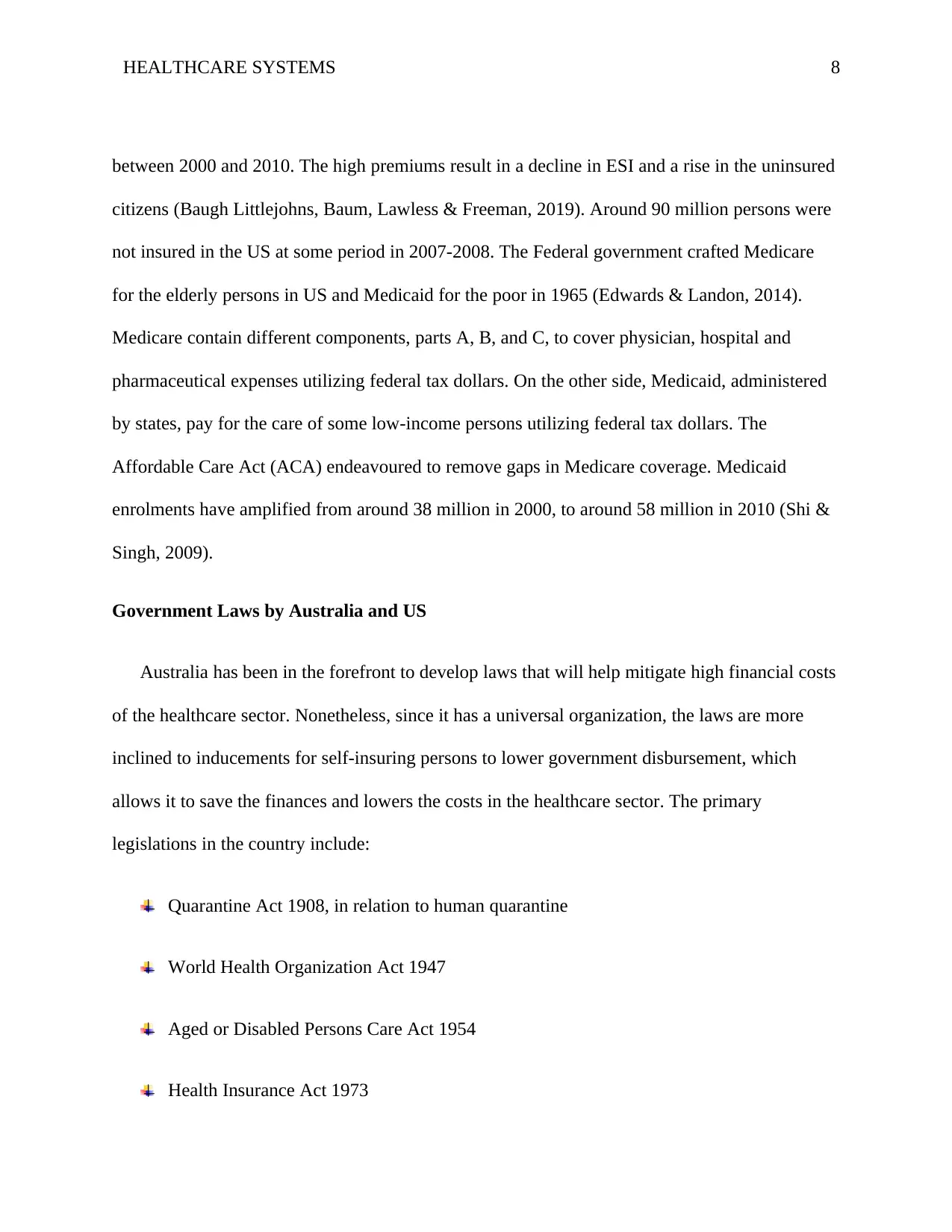
HEALTHCARE SYSTEMS 8
between 2000 and 2010. The high premiums result in a decline in ESI and a rise in the uninsured
citizens (Baugh Littlejohns, Baum, Lawless & Freeman, 2019). Around 90 million persons were
not insured in the US at some period in 2007-2008. The Federal government crafted Medicare
for the elderly persons in US and Medicaid for the poor in 1965 (Edwards & Landon, 2014).
Medicare contain different components, parts A, B, and C, to cover physician, hospital and
pharmaceutical expenses utilizing federal tax dollars. On the other side, Medicaid, administered
by states, pay for the care of some low-income persons utilizing federal tax dollars. The
Affordable Care Act (ACA) endeavoured to remove gaps in Medicare coverage. Medicaid
enrolments have amplified from around 38 million in 2000, to around 58 million in 2010 (Shi &
Singh, 2009).
Government Laws by Australia and US
Australia has been in the forefront to develop laws that will help mitigate high financial costs
of the healthcare sector. Nonetheless, since it has a universal organization, the laws are more
inclined to inducements for self-insuring persons to lower government disbursement, which
allows it to save the finances and lowers the costs in the healthcare sector. The primary
legislations in the country include:
Quarantine Act 1908, in relation to human quarantine
World Health Organization Act 1947
Aged or Disabled Persons Care Act 1954
Health Insurance Act 1973
between 2000 and 2010. The high premiums result in a decline in ESI and a rise in the uninsured
citizens (Baugh Littlejohns, Baum, Lawless & Freeman, 2019). Around 90 million persons were
not insured in the US at some period in 2007-2008. The Federal government crafted Medicare
for the elderly persons in US and Medicaid for the poor in 1965 (Edwards & Landon, 2014).
Medicare contain different components, parts A, B, and C, to cover physician, hospital and
pharmaceutical expenses utilizing federal tax dollars. On the other side, Medicaid, administered
by states, pay for the care of some low-income persons utilizing federal tax dollars. The
Affordable Care Act (ACA) endeavoured to remove gaps in Medicare coverage. Medicaid
enrolments have amplified from around 38 million in 2000, to around 58 million in 2010 (Shi &
Singh, 2009).
Government Laws by Australia and US
Australia has been in the forefront to develop laws that will help mitigate high financial costs
of the healthcare sector. Nonetheless, since it has a universal organization, the laws are more
inclined to inducements for self-insuring persons to lower government disbursement, which
allows it to save the finances and lowers the costs in the healthcare sector. The primary
legislations in the country include:
Quarantine Act 1908, in relation to human quarantine
World Health Organization Act 1947
Aged or Disabled Persons Care Act 1954
Health Insurance Act 1973
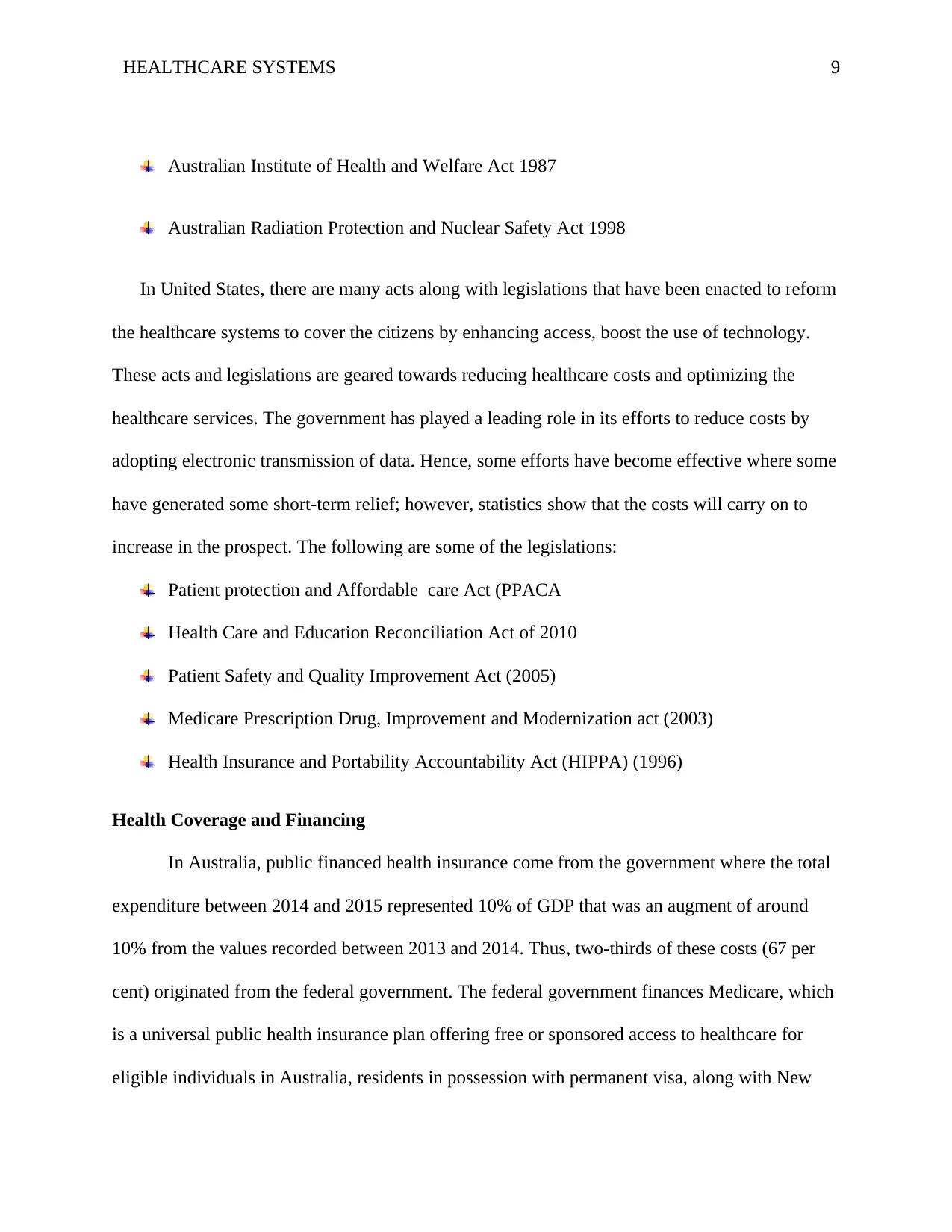
HEALTHCARE SYSTEMS 9
Australian Institute of Health and Welfare Act 1987
Australian Radiation Protection and Nuclear Safety Act 1998
In United States, there are many acts along with legislations that have been enacted to reform
the healthcare systems to cover the citizens by enhancing access, boost the use of technology.
These acts and legislations are geared towards reducing healthcare costs and optimizing the
healthcare services. The government has played a leading role in its efforts to reduce costs by
adopting electronic transmission of data. Hence, some efforts have become effective where some
have generated some short-term relief; however, statistics show that the costs will carry on to
increase in the prospect. The following are some of the legislations:
Patient protection and Affordable care Act (PPACA
Health Care and Education Reconciliation Act of 2010
Patient Safety and Quality Improvement Act (2005)
Medicare Prescription Drug, Improvement and Modernization act (2003)
Health Insurance and Portability Accountability Act (HIPPA) (1996)
Health Coverage and Financing
In Australia, public financed health insurance come from the government where the total
expenditure between 2014 and 2015 represented 10% of GDP that was an augment of around
10% from the values recorded between 2013 and 2014. Thus, two-thirds of these costs (67 per
cent) originated from the federal government. The federal government finances Medicare, which
is a universal public health insurance plan offering free or sponsored access to healthcare for
eligible individuals in Australia, residents in possession with permanent visa, along with New
Australian Institute of Health and Welfare Act 1987
Australian Radiation Protection and Nuclear Safety Act 1998
In United States, there are many acts along with legislations that have been enacted to reform
the healthcare systems to cover the citizens by enhancing access, boost the use of technology.
These acts and legislations are geared towards reducing healthcare costs and optimizing the
healthcare services. The government has played a leading role in its efforts to reduce costs by
adopting electronic transmission of data. Hence, some efforts have become effective where some
have generated some short-term relief; however, statistics show that the costs will carry on to
increase in the prospect. The following are some of the legislations:
Patient protection and Affordable care Act (PPACA
Health Care and Education Reconciliation Act of 2010
Patient Safety and Quality Improvement Act (2005)
Medicare Prescription Drug, Improvement and Modernization act (2003)
Health Insurance and Portability Accountability Act (HIPPA) (1996)
Health Coverage and Financing
In Australia, public financed health insurance come from the government where the total
expenditure between 2014 and 2015 represented 10% of GDP that was an augment of around
10% from the values recorded between 2013 and 2014. Thus, two-thirds of these costs (67 per
cent) originated from the federal government. The federal government finances Medicare, which
is a universal public health insurance plan offering free or sponsored access to healthcare for
eligible individuals in Australia, residents in possession with permanent visa, along with New
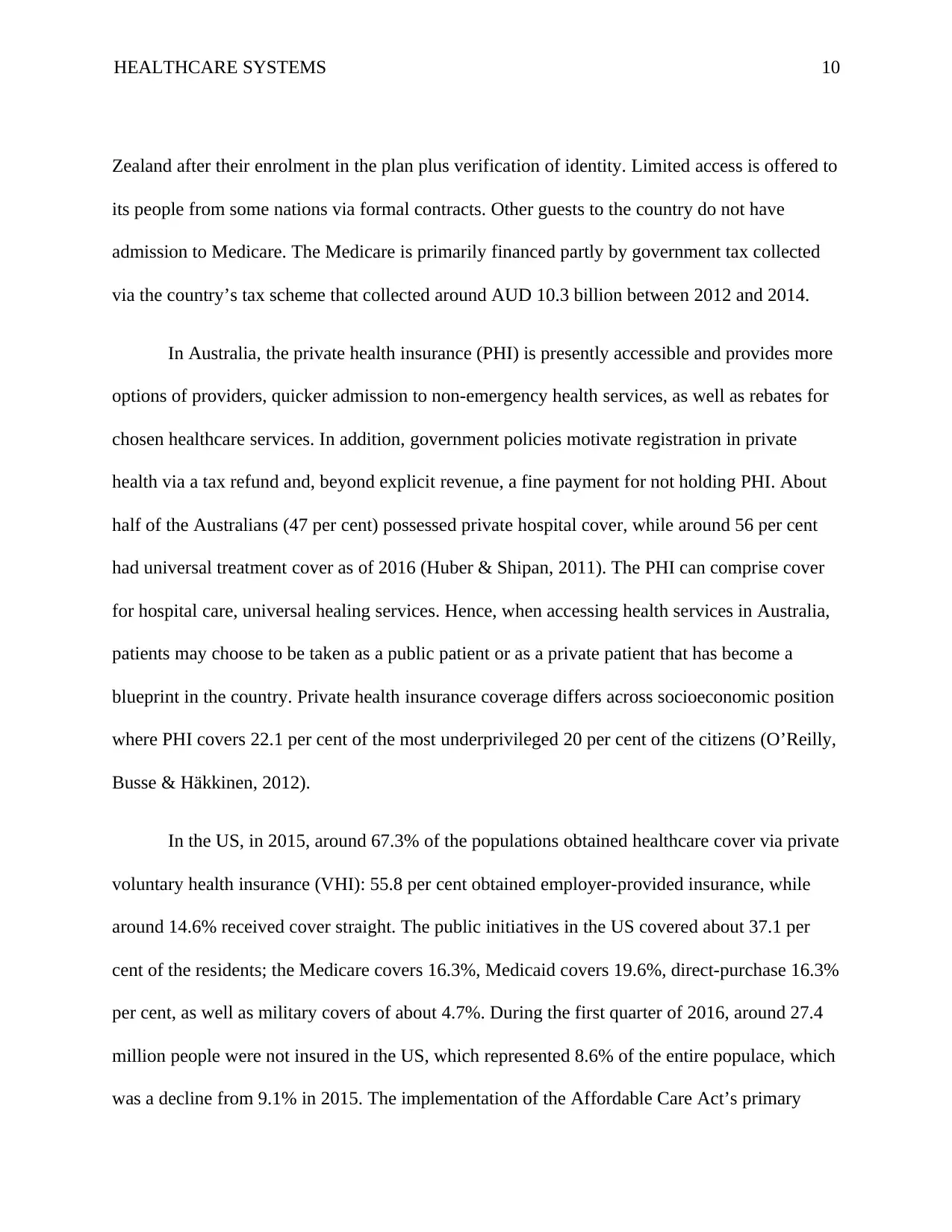
HEALTHCARE SYSTEMS 10
Zealand after their enrolment in the plan plus verification of identity. Limited access is offered to
its people from some nations via formal contracts. Other guests to the country do not have
admission to Medicare. The Medicare is primarily financed partly by government tax collected
via the country’s tax scheme that collected around AUD 10.3 billion between 2012 and 2014.
In Australia, the private health insurance (PHI) is presently accessible and provides more
options of providers, quicker admission to non-emergency health services, as well as rebates for
chosen healthcare services. In addition, government policies motivate registration in private
health via a tax refund and, beyond explicit revenue, a fine payment for not holding PHI. About
half of the Australians (47 per cent) possessed private hospital cover, while around 56 per cent
had universal treatment cover as of 2016 (Huber & Shipan, 2011). The PHI can comprise cover
for hospital care, universal healing services. Hence, when accessing health services in Australia,
patients may choose to be taken as a public patient or as a private patient that has become a
blueprint in the country. Private health insurance coverage differs across socioeconomic position
where PHI covers 22.1 per cent of the most underprivileged 20 per cent of the citizens (O’Reilly,
Busse & Häkkinen, 2012).
In the US, in 2015, around 67.3% of the populations obtained healthcare cover via private
voluntary health insurance (VHI): 55.8 per cent obtained employer-provided insurance, while
around 14.6% received cover straight. The public initiatives in the US covered about 37.1 per
cent of the residents; the Medicare covers 16.3%, Medicaid covers 19.6%, direct-purchase 16.3%
per cent, as well as military covers of about 4.7%. During the first quarter of 2016, around 27.4
million people were not insured in the US, which represented 8.6% of the entire populace, which
was a decline from 9.1% in 2015. The implementation of the Affordable Care Act’s primary
Zealand after their enrolment in the plan plus verification of identity. Limited access is offered to
its people from some nations via formal contracts. Other guests to the country do not have
admission to Medicare. The Medicare is primarily financed partly by government tax collected
via the country’s tax scheme that collected around AUD 10.3 billion between 2012 and 2014.
In Australia, the private health insurance (PHI) is presently accessible and provides more
options of providers, quicker admission to non-emergency health services, as well as rebates for
chosen healthcare services. In addition, government policies motivate registration in private
health via a tax refund and, beyond explicit revenue, a fine payment for not holding PHI. About
half of the Australians (47 per cent) possessed private hospital cover, while around 56 per cent
had universal treatment cover as of 2016 (Huber & Shipan, 2011). The PHI can comprise cover
for hospital care, universal healing services. Hence, when accessing health services in Australia,
patients may choose to be taken as a public patient or as a private patient that has become a
blueprint in the country. Private health insurance coverage differs across socioeconomic position
where PHI covers 22.1 per cent of the most underprivileged 20 per cent of the citizens (O’Reilly,
Busse & Häkkinen, 2012).
In the US, in 2015, around 67.3% of the populations obtained healthcare cover via private
voluntary health insurance (VHI): 55.8 per cent obtained employer-provided insurance, while
around 14.6% received cover straight. The public initiatives in the US covered about 37.1 per
cent of the residents; the Medicare covers 16.3%, Medicaid covers 19.6%, direct-purchase 16.3%
per cent, as well as military covers of about 4.7%. During the first quarter of 2016, around 27.4
million people were not insured in the US, which represented 8.6% of the entire populace, which
was a decline from 9.1% in 2015. The implementation of the Affordable Care Act’s primary
Paraphrase This Document
Need a fresh take? Get an instant paraphrase of this document with our AI Paraphraser
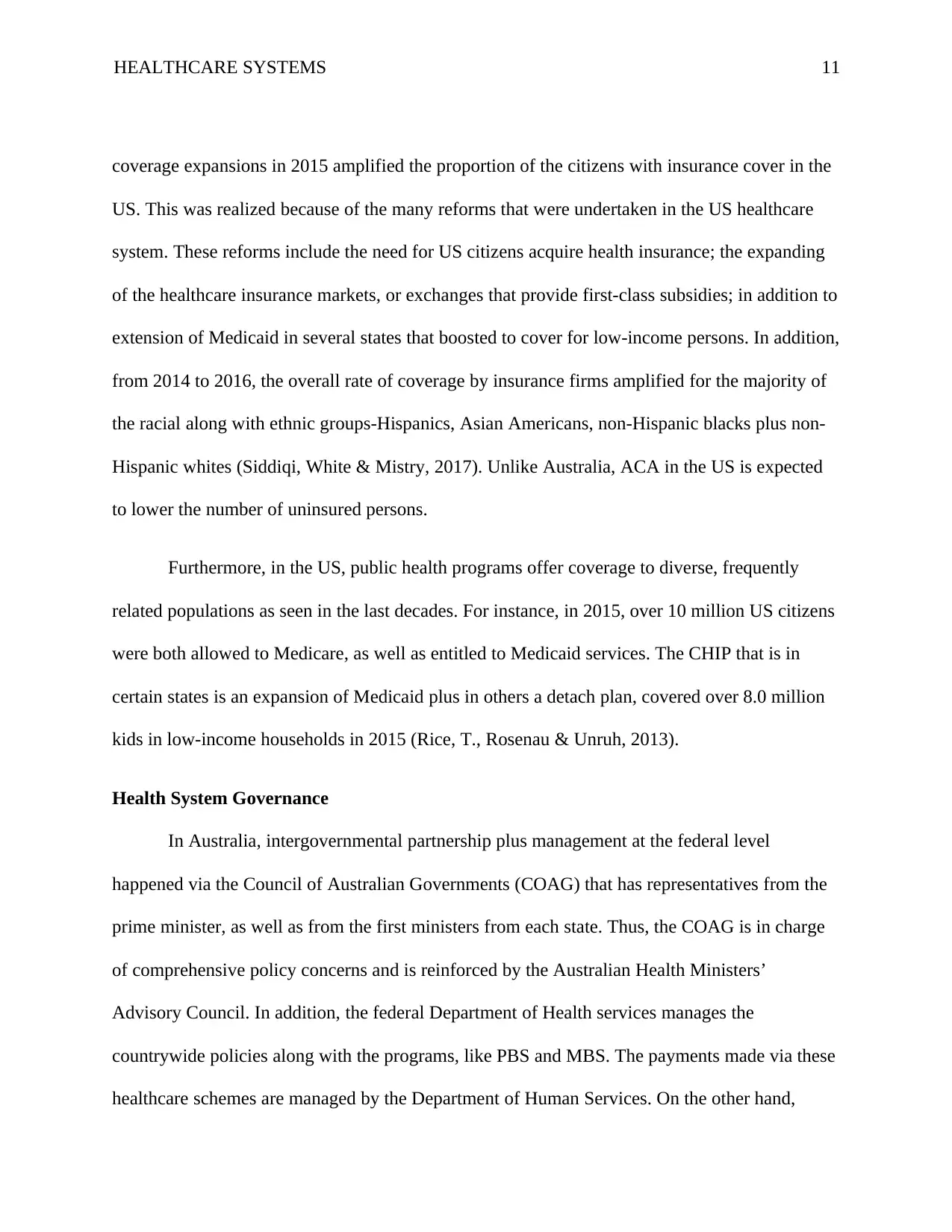
HEALTHCARE SYSTEMS 11
coverage expansions in 2015 amplified the proportion of the citizens with insurance cover in the
US. This was realized because of the many reforms that were undertaken in the US healthcare
system. These reforms include the need for US citizens acquire health insurance; the expanding
of the healthcare insurance markets, or exchanges that provide first-class subsidies; in addition to
extension of Medicaid in several states that boosted to cover for low-income persons. In addition,
from 2014 to 2016, the overall rate of coverage by insurance firms amplified for the majority of
the racial along with ethnic groups-Hispanics, Asian Americans, non-Hispanic blacks plus non-
Hispanic whites (Siddiqi, White & Mistry, 2017). Unlike Australia, ACA in the US is expected
to lower the number of uninsured persons.
Furthermore, in the US, public health programs offer coverage to diverse, frequently
related populations as seen in the last decades. For instance, in 2015, over 10 million US citizens
were both allowed to Medicare, as well as entitled to Medicaid services. The CHIP that is in
certain states is an expansion of Medicaid plus in others a detach plan, covered over 8.0 million
kids in low-income households in 2015 (Rice, T., Rosenau & Unruh, 2013).
Health System Governance
In Australia, intergovernmental partnership plus management at the federal level
happened via the Council of Australian Governments (COAG) that has representatives from the
prime minister, as well as from the first ministers from each state. Thus, the COAG is in charge
of comprehensive policy concerns and is reinforced by the Australian Health Ministers’
Advisory Council. In addition, the federal Department of Health services manages the
countrywide policies along with the programs, like PBS and MBS. The payments made via these
healthcare schemes are managed by the Department of Human Services. On the other hand,
coverage expansions in 2015 amplified the proportion of the citizens with insurance cover in the
US. This was realized because of the many reforms that were undertaken in the US healthcare
system. These reforms include the need for US citizens acquire health insurance; the expanding
of the healthcare insurance markets, or exchanges that provide first-class subsidies; in addition to
extension of Medicaid in several states that boosted to cover for low-income persons. In addition,
from 2014 to 2016, the overall rate of coverage by insurance firms amplified for the majority of
the racial along with ethnic groups-Hispanics, Asian Americans, non-Hispanic blacks plus non-
Hispanic whites (Siddiqi, White & Mistry, 2017). Unlike Australia, ACA in the US is expected
to lower the number of uninsured persons.
Furthermore, in the US, public health programs offer coverage to diverse, frequently
related populations as seen in the last decades. For instance, in 2015, over 10 million US citizens
were both allowed to Medicare, as well as entitled to Medicaid services. The CHIP that is in
certain states is an expansion of Medicaid plus in others a detach plan, covered over 8.0 million
kids in low-income households in 2015 (Rice, T., Rosenau & Unruh, 2013).
Health System Governance
In Australia, intergovernmental partnership plus management at the federal level
happened via the Council of Australian Governments (COAG) that has representatives from the
prime minister, as well as from the first ministers from each state. Thus, the COAG is in charge
of comprehensive policy concerns and is reinforced by the Australian Health Ministers’
Advisory Council. In addition, the federal Department of Health services manages the
countrywide policies along with the programs, like PBS and MBS. The payments made via these
healthcare schemes are managed by the Department of Human Services. On the other hand,
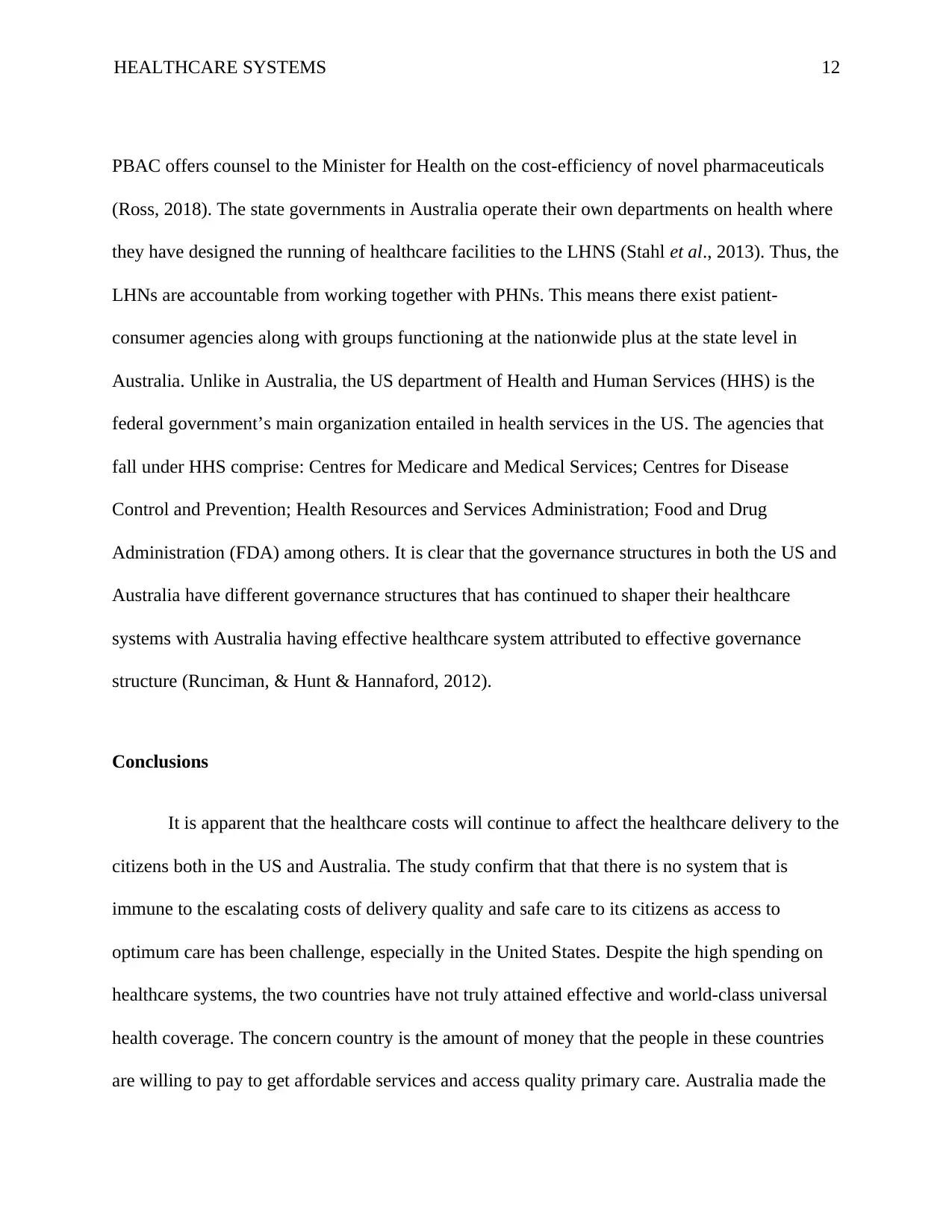
HEALTHCARE SYSTEMS 12
PBAC offers counsel to the Minister for Health on the cost-efficiency of novel pharmaceuticals
(Ross, 2018). The state governments in Australia operate their own departments on health where
they have designed the running of healthcare facilities to the LHNS (Stahl et al., 2013). Thus, the
LHNs are accountable from working together with PHNs. This means there exist patient-
consumer agencies along with groups functioning at the nationwide plus at the state level in
Australia. Unlike in Australia, the US department of Health and Human Services (HHS) is the
federal government’s main organization entailed in health services in the US. The agencies that
fall under HHS comprise: Centres for Medicare and Medical Services; Centres for Disease
Control and Prevention; Health Resources and Services Administration; Food and Drug
Administration (FDA) among others. It is clear that the governance structures in both the US and
Australia have different governance structures that has continued to shaper their healthcare
systems with Australia having effective healthcare system attributed to effective governance
structure (Runciman, & Hunt & Hannaford, 2012).
Conclusions
It is apparent that the healthcare costs will continue to affect the healthcare delivery to the
citizens both in the US and Australia. The study confirm that that there is no system that is
immune to the escalating costs of delivery quality and safe care to its citizens as access to
optimum care has been challenge, especially in the United States. Despite the high spending on
healthcare systems, the two countries have not truly attained effective and world-class universal
health coverage. The concern country is the amount of money that the people in these countries
are willing to pay to get affordable services and access quality primary care. Australia made the
PBAC offers counsel to the Minister for Health on the cost-efficiency of novel pharmaceuticals
(Ross, 2018). The state governments in Australia operate their own departments on health where
they have designed the running of healthcare facilities to the LHNS (Stahl et al., 2013). Thus, the
LHNs are accountable from working together with PHNs. This means there exist patient-
consumer agencies along with groups functioning at the nationwide plus at the state level in
Australia. Unlike in Australia, the US department of Health and Human Services (HHS) is the
federal government’s main organization entailed in health services in the US. The agencies that
fall under HHS comprise: Centres for Medicare and Medical Services; Centres for Disease
Control and Prevention; Health Resources and Services Administration; Food and Drug
Administration (FDA) among others. It is clear that the governance structures in both the US and
Australia have different governance structures that has continued to shaper their healthcare
systems with Australia having effective healthcare system attributed to effective governance
structure (Runciman, & Hunt & Hannaford, 2012).
Conclusions
It is apparent that the healthcare costs will continue to affect the healthcare delivery to the
citizens both in the US and Australia. The study confirm that that there is no system that is
immune to the escalating costs of delivery quality and safe care to its citizens as access to
optimum care has been challenge, especially in the United States. Despite the high spending on
healthcare systems, the two countries have not truly attained effective and world-class universal
health coverage. The concern country is the amount of money that the people in these countries
are willing to pay to get affordable services and access quality primary care. Australia made the
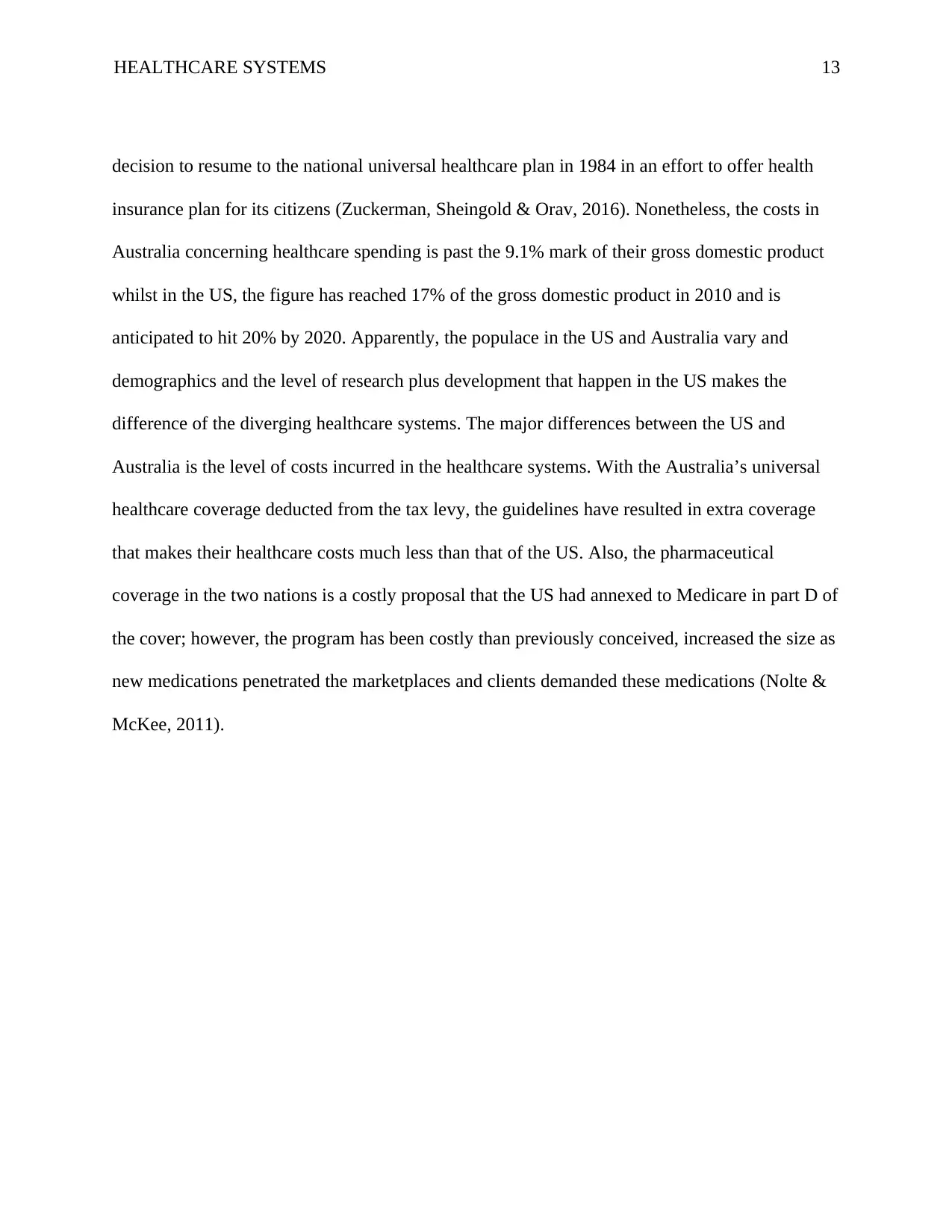
HEALTHCARE SYSTEMS 13
decision to resume to the national universal healthcare plan in 1984 in an effort to offer health
insurance plan for its citizens (Zuckerman, Sheingold & Orav, 2016). Nonetheless, the costs in
Australia concerning healthcare spending is past the 9.1% mark of their gross domestic product
whilst in the US, the figure has reached 17% of the gross domestic product in 2010 and is
anticipated to hit 20% by 2020. Apparently, the populace in the US and Australia vary and
demographics and the level of research plus development that happen in the US makes the
difference of the diverging healthcare systems. The major differences between the US and
Australia is the level of costs incurred in the healthcare systems. With the Australia’s universal
healthcare coverage deducted from the tax levy, the guidelines have resulted in extra coverage
that makes their healthcare costs much less than that of the US. Also, the pharmaceutical
coverage in the two nations is a costly proposal that the US had annexed to Medicare in part D of
the cover; however, the program has been costly than previously conceived, increased the size as
new medications penetrated the marketplaces and clients demanded these medications (Nolte &
McKee, 2011).
decision to resume to the national universal healthcare plan in 1984 in an effort to offer health
insurance plan for its citizens (Zuckerman, Sheingold & Orav, 2016). Nonetheless, the costs in
Australia concerning healthcare spending is past the 9.1% mark of their gross domestic product
whilst in the US, the figure has reached 17% of the gross domestic product in 2010 and is
anticipated to hit 20% by 2020. Apparently, the populace in the US and Australia vary and
demographics and the level of research plus development that happen in the US makes the
difference of the diverging healthcare systems. The major differences between the US and
Australia is the level of costs incurred in the healthcare systems. With the Australia’s universal
healthcare coverage deducted from the tax levy, the guidelines have resulted in extra coverage
that makes their healthcare costs much less than that of the US. Also, the pharmaceutical
coverage in the two nations is a costly proposal that the US had annexed to Medicare in part D of
the cover; however, the program has been costly than previously conceived, increased the size as
new medications penetrated the marketplaces and clients demanded these medications (Nolte &
McKee, 2011).
Secure Best Marks with AI Grader
Need help grading? Try our AI Grader for instant feedback on your assignments.
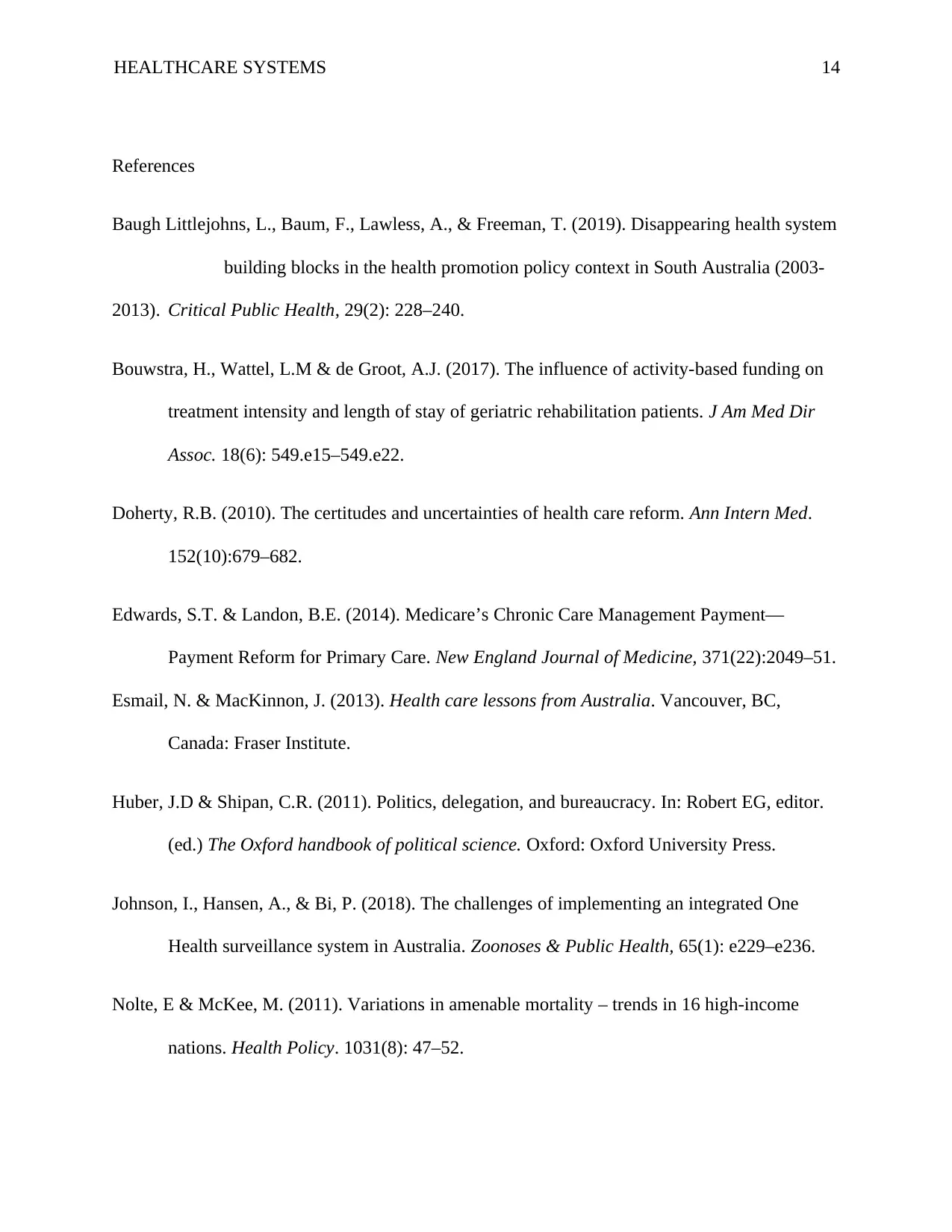
HEALTHCARE SYSTEMS 14
References
Baugh Littlejohns, L., Baum, F., Lawless, A., & Freeman, T. (2019). Disappearing health system
building blocks in the health promotion policy context in South Australia (2003-
2013). Critical Public Health, 29(2): 228–240.
Bouwstra, H., Wattel, L.M & de Groot, A.J. (2017). The influence of activity-based funding on
treatment intensity and length of stay of geriatric rehabilitation patients. J Am Med Dir
Assoc. 18(6): 549.e15–549.e22.
Doherty, R.B. (2010). The certitudes and uncertainties of health care reform. Ann Intern Med.
152(10):679–682.
Edwards, S.T. & Landon, B.E. (2014). Medicare’s Chronic Care Management Payment—
Payment Reform for Primary Care. New England Journal of Medicine, 371(22):2049–51.
Esmail, N. & MacKinnon, J. (2013). Health care lessons from Australia. Vancouver, BC,
Canada: Fraser Institute.
Huber, J.D & Shipan, C.R. (2011). Politics, delegation, and bureaucracy. In: Robert EG, editor.
(ed.) The Oxford handbook of political science. Oxford: Oxford University Press.
Johnson, I., Hansen, A., & Bi, P. (2018). The challenges of implementing an integrated One
Health surveillance system in Australia. Zoonoses & Public Health, 65(1): e229–e236.
Nolte, E & McKee, M. (2011). Variations in amenable mortality – trends in 16 high-income
nations. Health Policy. 1031(8): 47–52.
References
Baugh Littlejohns, L., Baum, F., Lawless, A., & Freeman, T. (2019). Disappearing health system
building blocks in the health promotion policy context in South Australia (2003-
2013). Critical Public Health, 29(2): 228–240.
Bouwstra, H., Wattel, L.M & de Groot, A.J. (2017). The influence of activity-based funding on
treatment intensity and length of stay of geriatric rehabilitation patients. J Am Med Dir
Assoc. 18(6): 549.e15–549.e22.
Doherty, R.B. (2010). The certitudes and uncertainties of health care reform. Ann Intern Med.
152(10):679–682.
Edwards, S.T. & Landon, B.E. (2014). Medicare’s Chronic Care Management Payment—
Payment Reform for Primary Care. New England Journal of Medicine, 371(22):2049–51.
Esmail, N. & MacKinnon, J. (2013). Health care lessons from Australia. Vancouver, BC,
Canada: Fraser Institute.
Huber, J.D & Shipan, C.R. (2011). Politics, delegation, and bureaucracy. In: Robert EG, editor.
(ed.) The Oxford handbook of political science. Oxford: Oxford University Press.
Johnson, I., Hansen, A., & Bi, P. (2018). The challenges of implementing an integrated One
Health surveillance system in Australia. Zoonoses & Public Health, 65(1): e229–e236.
Nolte, E & McKee, M. (2011). Variations in amenable mortality – trends in 16 high-income
nations. Health Policy. 1031(8): 47–52.

HEALTHCARE SYSTEMS 15
O’Reilly, J., Busse, R, & Häkkinen, U. (2012). Paying for hospital care: the experience with
implementing activity-based funding in five European countries. Health Econ Policy
Law. 7(1): 73–101.
Papanicolas, I., Woskie, L. R., & Jha, A. K. (2018). Health Care Spending in the United States
and Other High-Income Countries. JAMA: Journal of the American Medical Association,
319(10): 1024–1039.
Penm, J., MacKinnon, N. J., Strakowski, S. M., Jun Ying, Doty, M. M., & Ying, J. (2017).
Minding the Gap: Factors Associated With Primary Care Coordination of Adults in 11
Countries. Annals of Family Medicine, 15(2): 113–119.
Raparelli, V., Pilote, L., Krumholz, H. M., & Dreyer, R. P. (2018). Abstract 16866: Sex
Differences in Access to Care Before Acute Myocardial Infarction: Does the Health Care
System Matter? Circulation, 138(4): A16866.
Rice, T., Rosenau, P. & Unruh, L.Y. (2013). United States of America: Health System Review.
Health Systems in Transition, 15(3):1–431.
Ross, D. (2018). A Social Work Perspective on Seclusion and Restraint in Australia’s Public
Mental Health System. Journal of Progressive Human Services, 29(2): 130–148.
Runciman, W.B & Hunt, T.D & Hannaford, N.A (2012). CareTrack: assessing the
appropriateness of health care delivery in Australia. Med J Aust. 197(2): 100–105.
Shi, L. & Singh, D. (2009). Delivering health care in America a systems approach. (4th ed.).
Sudburry, MS: Jones and Bartlett.
O’Reilly, J., Busse, R, & Häkkinen, U. (2012). Paying for hospital care: the experience with
implementing activity-based funding in five European countries. Health Econ Policy
Law. 7(1): 73–101.
Papanicolas, I., Woskie, L. R., & Jha, A. K. (2018). Health Care Spending in the United States
and Other High-Income Countries. JAMA: Journal of the American Medical Association,
319(10): 1024–1039.
Penm, J., MacKinnon, N. J., Strakowski, S. M., Jun Ying, Doty, M. M., & Ying, J. (2017).
Minding the Gap: Factors Associated With Primary Care Coordination of Adults in 11
Countries. Annals of Family Medicine, 15(2): 113–119.
Raparelli, V., Pilote, L., Krumholz, H. M., & Dreyer, R. P. (2018). Abstract 16866: Sex
Differences in Access to Care Before Acute Myocardial Infarction: Does the Health Care
System Matter? Circulation, 138(4): A16866.
Rice, T., Rosenau, P. & Unruh, L.Y. (2013). United States of America: Health System Review.
Health Systems in Transition, 15(3):1–431.
Ross, D. (2018). A Social Work Perspective on Seclusion and Restraint in Australia’s Public
Mental Health System. Journal of Progressive Human Services, 29(2): 130–148.
Runciman, W.B & Hunt, T.D & Hannaford, N.A (2012). CareTrack: assessing the
appropriateness of health care delivery in Australia. Med J Aust. 197(2): 100–105.
Shi, L. & Singh, D. (2009). Delivering health care in America a systems approach. (4th ed.).
Sudburry, MS: Jones and Bartlett.
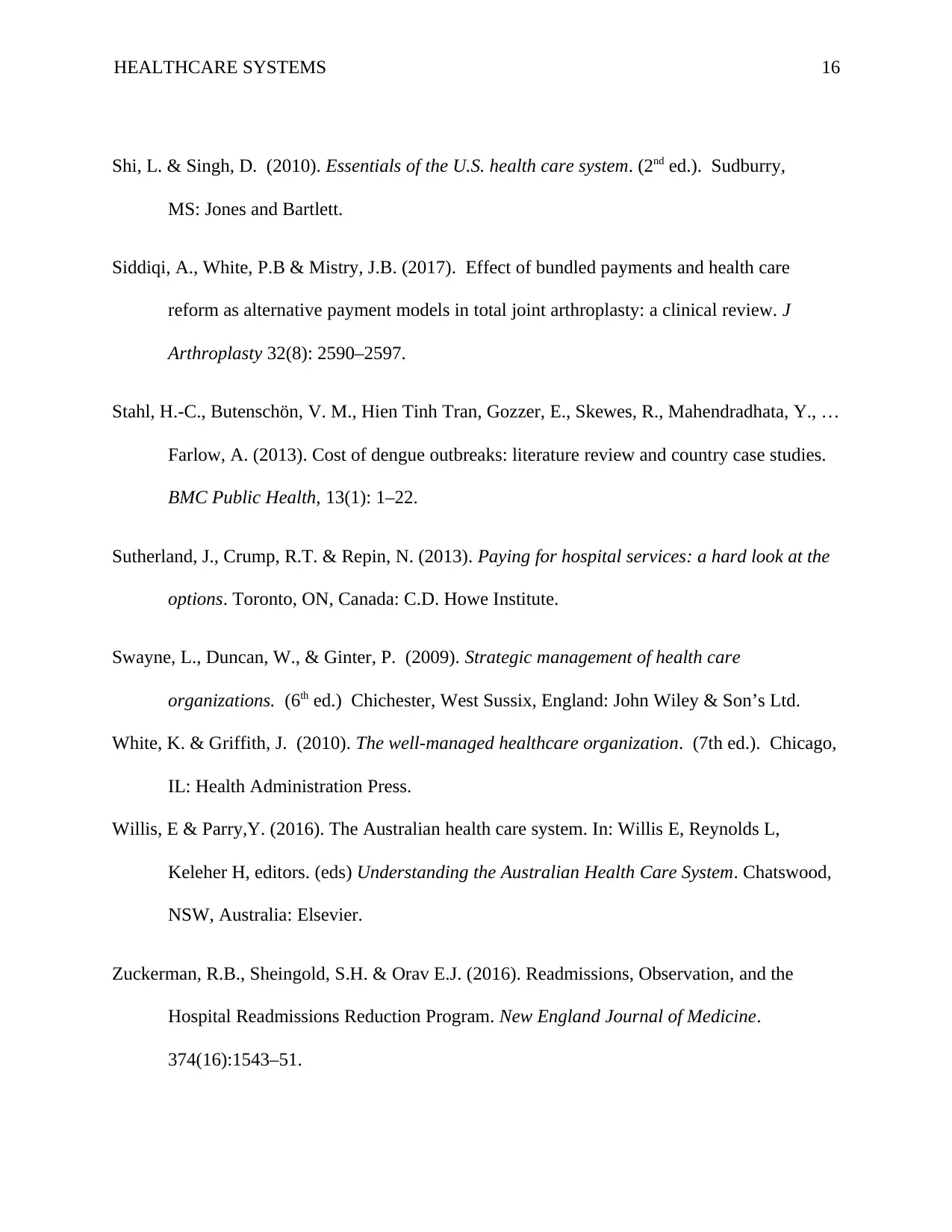
HEALTHCARE SYSTEMS 16
Shi, L. & Singh, D. (2010). Essentials of the U.S. health care system. (2nd ed.). Sudburry,
MS: Jones and Bartlett.
Siddiqi, A., White, P.B & Mistry, J.B. (2017). Effect of bundled payments and health care
reform as alternative payment models in total joint arthroplasty: a clinical review. J
Arthroplasty 32(8): 2590–2597.
Stahl, H.-C., Butenschön, V. M., Hien Tinh Tran, Gozzer, E., Skewes, R., Mahendradhata, Y., …
Farlow, A. (2013). Cost of dengue outbreaks: literature review and country case studies.
BMC Public Health, 13(1): 1–22.
Sutherland, J., Crump, R.T. & Repin, N. (2013). Paying for hospital services: a hard look at the
options. Toronto, ON, Canada: C.D. Howe Institute.
Swayne, L., Duncan, W., & Ginter, P. (2009). Strategic management of health care
organizations. (6th ed.) Chichester, West Sussix, England: John Wiley & Son’s Ltd.
White, K. & Griffith, J. (2010). The well-managed healthcare organization. (7th ed.). Chicago,
IL: Health Administration Press.
Willis, E & Parry,Y. (2016). The Australian health care system. In: Willis E, Reynolds L,
Keleher H, editors. (eds) Understanding the Australian Health Care System. Chatswood,
NSW, Australia: Elsevier.
Zuckerman, R.B., Sheingold, S.H. & Orav E.J. (2016). Readmissions, Observation, and the
Hospital Readmissions Reduction Program. New England Journal of Medicine.
374(16):1543–51.
Shi, L. & Singh, D. (2010). Essentials of the U.S. health care system. (2nd ed.). Sudburry,
MS: Jones and Bartlett.
Siddiqi, A., White, P.B & Mistry, J.B. (2017). Effect of bundled payments and health care
reform as alternative payment models in total joint arthroplasty: a clinical review. J
Arthroplasty 32(8): 2590–2597.
Stahl, H.-C., Butenschön, V. M., Hien Tinh Tran, Gozzer, E., Skewes, R., Mahendradhata, Y., …
Farlow, A. (2013). Cost of dengue outbreaks: literature review and country case studies.
BMC Public Health, 13(1): 1–22.
Sutherland, J., Crump, R.T. & Repin, N. (2013). Paying for hospital services: a hard look at the
options. Toronto, ON, Canada: C.D. Howe Institute.
Swayne, L., Duncan, W., & Ginter, P. (2009). Strategic management of health care
organizations. (6th ed.) Chichester, West Sussix, England: John Wiley & Son’s Ltd.
White, K. & Griffith, J. (2010). The well-managed healthcare organization. (7th ed.). Chicago,
IL: Health Administration Press.
Willis, E & Parry,Y. (2016). The Australian health care system. In: Willis E, Reynolds L,
Keleher H, editors. (eds) Understanding the Australian Health Care System. Chatswood,
NSW, Australia: Elsevier.
Zuckerman, R.B., Sheingold, S.H. & Orav E.J. (2016). Readmissions, Observation, and the
Hospital Readmissions Reduction Program. New England Journal of Medicine.
374(16):1543–51.
Paraphrase This Document
Need a fresh take? Get an instant paraphrase of this document with our AI Paraphraser
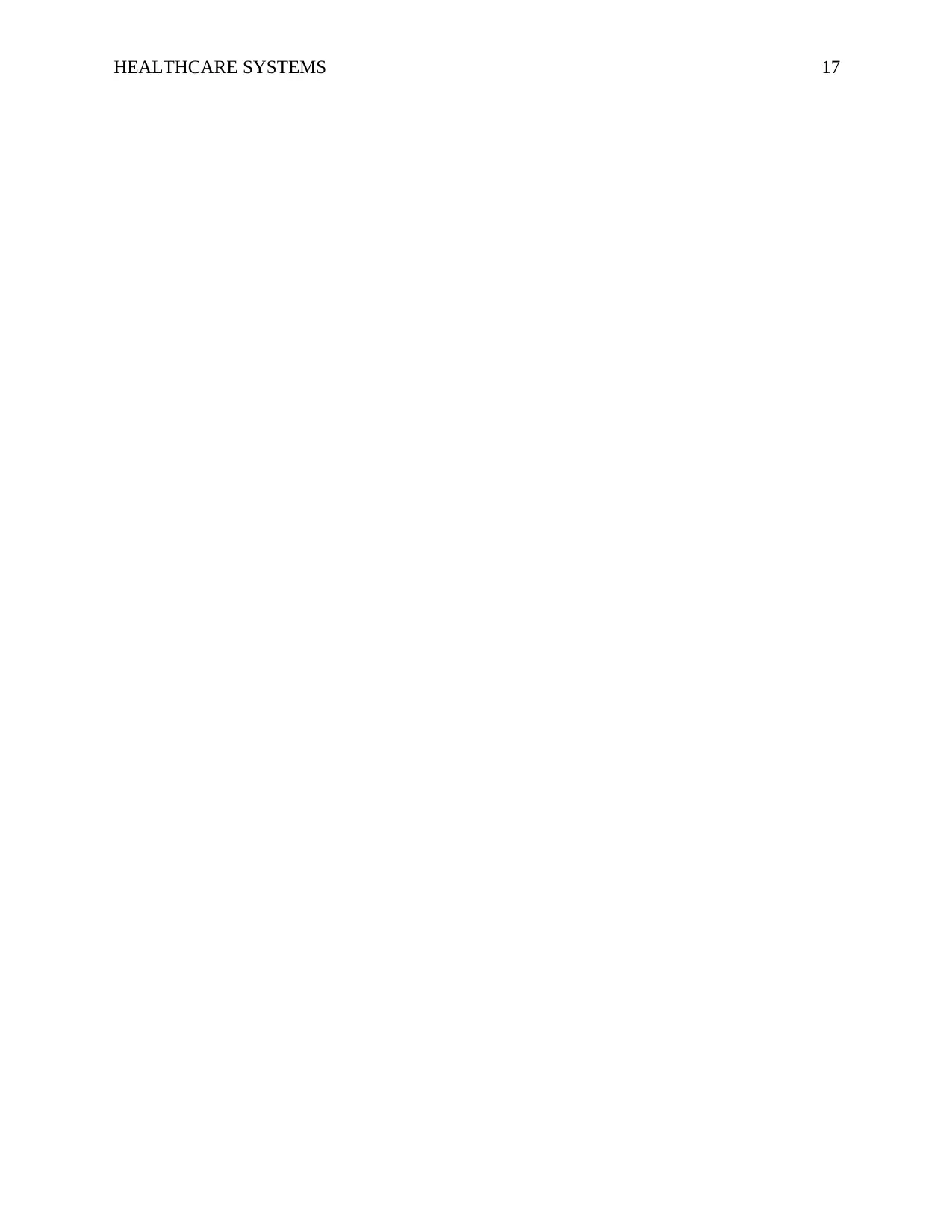
HEALTHCARE SYSTEMS 17
1 out of 17
![[object Object]](/_next/static/media/star-bottom.7253800d.svg)





